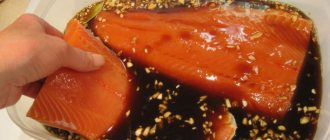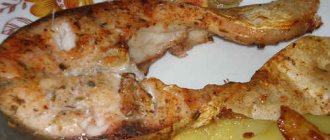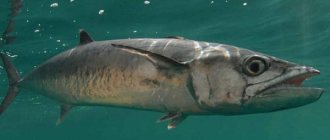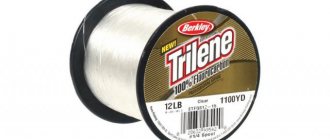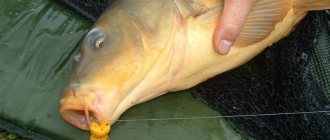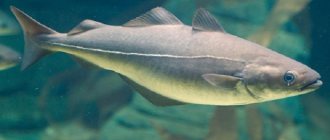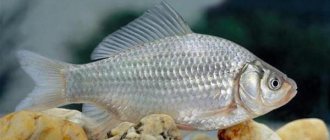Kalkan is one of the largest fish in the Black Sea. Some individuals can be about 80 centimeters long and weigh up to 15 kilograms. And with an average size, the mass of the Kalkan does not exceed 3-5 kg. The photo shows that, like all flounders, the Kalkan's eyes are located on one side.
Do you like fried flounder?
- Yes 91%, 755 votes
755 votes 91%755 votes - 91% of all votes
- I will cook according to your recipes 6%, 47 votes
47 votes 6%
47 votes - 6% of all votes
- No 3%, 23 votes
23 votes 3%
23 votes - 3% of all votes
- I don't eat fish 1%, 5 votes
5 votes 1%
5 votes - 1% of all votes
Total votes: 830
28.04.2020
×
You or from your IP have already voted.
Habitat
Where does the flounder fish live? Habitat: silty and shell (sandy) soils. Found at depths of up to 100 meters. A smaller subspecies lives in the Sea of Azov. In summer and winter, Kalkan prefers to stay at depth. And in autumn and spring, it floats up in shallow water. In summer, large young fish can be seen swimming near the bottom in beach areas.
Sea flounder
The salty environment is home to dozens of species of flat fish that thrive both on the shallow coastal shelf and at depths of several kilometers. They are characterized by a wide variation in size, body shape, fin color, sighted and blind sides.
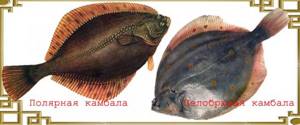
Common sole
The basic taxon (Pleuronectes platessa), living in low- and high-salinity water (10-40%) at depths of 30-200 m, is an important commercial fish object. Inhabits the Eastern Atlantic, Mediterranean, White, Barents, Baltic and other seas. The main color is brown-green with reddish or orange spots. It grows up to 6-7 kg, maximum size up to 1 m. It has well-developed mimicry.
White-bellied flounder
Sea bottom fish that grows up to half a meter. The minimum commercial size is 21 cm. Features of appearance are an arched diluted lateral line, milky color of the blind side, brown or wheat-brown color of the eye side. There are two subspecies:
- Southern white-bellied flounder (Lepidopsetta bilineata mochigarei) lives in the coastal zone of Primorye and the Sea of Japan.
- Northern (Lepidopsetta bilineata bilineata) - in the waters of the Kamchatka, Okhotsk and Bering seas. Both form large populations in Peter the Great Bay (southern Primorsky Krai) and the Strait of Tartary, which separates Sakhalin from the mainland.
Yellowfin flounder
A cold-loving species (Limanda aspera) from the genus Limanda, which is common in the Sea of Okhotsk, Japan and Bering Sea. Fish are plentiful off the western coast of Kamchatka and Sakhalin. Prefers depths of 15-80 meters, where it adheres to sandy soils. Other common names for the taxon - spiny limanda and red flounder - are given because of the spiked scales and rounded brown body framed by yellow-golden fins. The maximum size is 45-50 cm with a weight of 0.9-1.0 kg.
Far Eastern flounder
Collective name for a dozen taxa of flat fish. In addition to the yellowfin, star and white-bellied forms, there are two-lined, long-snouted, proboscis, halibut, yellow-bellied, warty and others. It is the northern territories that provide the majority of the world's catch of flounder.
Appearance
What does the Black Sea fish flounder look like? Its description is very different from other species. The Kalkan has a tall, elongated body, somewhat flattened, with a height of up to 80% of its own length. Sometimes it happens even more. The entire body is covered with bony tubercles. Like other relatives of this species (flounders), it is formed in the form of horizontally located sides, like a thick pancake.
The eyes of the Black Sea flounder are located on the upper (left) side. The fins on this side are asymmetrical. From below, white-bellied turbot. On top, where the eyes are located, it is brownish, with small reddish spots. The Kalkan has no scales at all, but at the slightest danger it can change color to match the color of the bottom. The jaws of this fish have bristly, even teeth. They are arranged in the form of ribbons. There are teeth even on the vomer.

Reproduction
Basically, the reproductive organs of male Black Sea flounder mature at the age of 5 to 8 years, and females - from 6 to 11. Reproduction occurs at a depth of 25 to 70 meters in the open sea. Favorable temperature should be from 8 to 12 degrees. Reproduction begins in March-April and continues until June. In some places until the end of July. But the peak of spawning occurs in May.
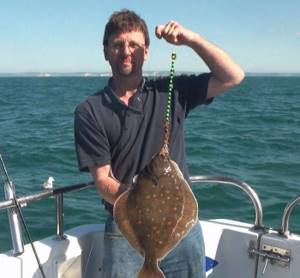
One fish spawns up to thirteen million eggs. Black Sea flounder is the most prolific fish in the Black Sea. Despite the fact that the kalkan dies from sometimes unfavorable living conditions and is often destroyed by sea predators, the huge amount of spawned eggs fully compensates for these losses.
Flounder spawning
The spawning time for each taxon is different and depends on the region, the timing of spring, and the rate of water warming (up to +2-5°C). The general breeding season for most species falls between February and May. But there are exceptions - turbot (large diamond) goes to spawn in the Baltic and North Seas in April-August, and polar flounder spawns in the ice-covered Kara and Barents Seas in December-January.
Puberty occurs between the 3rd and 7th years of life. Females are characterized by high fertility; one clutch can contain 0.5-2 million pelagic eggs with an incubation period of 11-14 days. Deep (7-15 m) coastal areas with a sandy bottom are chosen as spawning grounds, although flounder successfully spawn at depths of up to 50 m due to the high buoyancy of the eggs and the absence of the need to attach them to a solid substrate. The swimmable fry has a classic vertical shape with symmetrically developed sides. Zooplankton and small benthos serve as nutritious food base.
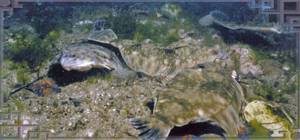
Maturation of eggs
Kalkan eggs are transparent and spherical in shape. With a small drop of fat. The caviar of the Black Sea flounder is buoyant, stays close to the surface and is carried by the current. As a result, per 1 sq. m. water accounts for up to 10 eggs. Many of them die in polluted waters or are eaten by marine life. Therefore, out of half a million eggs, only 500 larvae mature.
For the first four days they have a yolk sac, which they feed on. On the fifth day, the mouth begins to form. But their vision is still poor, so they move very slowly. This is a critical period, as out of 500 larvae, only 25 survive.
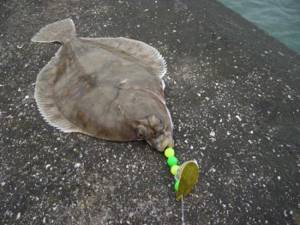
After 15 or 20 days they become fry and settle to the bottom. Approximately 6 young individuals survive by autumn. Their length is initially 7 centimeters. They winter at a depth of 30 meters. In spring, young Kalkans move to the coastal zone. By this time, their length is already 10 centimeters, and by autumn it reaches 16 cm. At this age, the Black Sea flounder has no enemies except the dogfish shark.
The kalkan spends its second winter at a depth of 50 meters. By spring it becomes 20 centimeters long. At four years old, the Kalkan is already 35 centimeters. Some individuals begin to spawn already at this age.
River flounder
The species Platichthys flesus, large in population but poor in related taxa, has successfully acclimatized for permanent residence in fresh and slightly salty water. It is distinguished by a rounded body and spines on the lateral line. The sighted side has a dull brown or olive-brown color with chaotic yellow and dark specks. It will grow up to 3 kg with a body length of 50 cm.
For full development, the clutch of flounder must constantly receive a fresh supply of oxygen due to drift in the water column (pelagic eggs). But this is only possible in a dense salty environment (from 10 ppm). In freshwater rivers, the larvae do not maintain buoyancy, sink to the bottom and die, so the fish go to sea to spawn.
The cool Baltic is ideal for these purposes with a vast basin, low salinity (11-12%), a long coastline, moderate depths of 30-50 m and a rich food supply. The river species is also officially called the Baltic flounder due to its wide distribution in the coastal zone, inflowing rivers and the sea.
Star flounder
The species Platichthys stellatus lives in the northern waters of the Pacific Ocean (Bering, Okhotsk, Chukchi, Sea of Japan). The freshwater form inhabits lagoons, bays and lower reaches of rivers (150-200 km from the mouth). It has left-sided eyes, dark color (greenish, brown), wide black stripes on the fins and star-shaped spiked plates on the eye side. Due to its distribution, the taxon is also known as the Pacific river flounder. The usual size of the fish is 50-60 cm and weighs 3-4 kg. There are frequent cases of catching large individuals weighing 7-9 kg (75-90 cm).
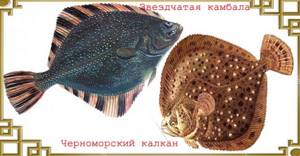
Black Sea Kalkan
The fish is similar to flounder, but belongs to a separate family called Scophthalmidae. Inhabits the North Atlantic and the Black, Baltic, and Mediterranean seas. It grows over a meter in length and weighs up to 20 kg. It is distinguished by the left location of the eyes, its round shape and a large number of tuberous spines scattered over the entire surface of the brown-olive sighted side. In addition to the marine environment, it thrives in the lower reaches of the Dnieper, Southern Bug, and Dniester. Due to the increased salinity of the Sea of Azov due to the shallowing of the inflowing rivers, the Black Sea flounder has spread to the mouth of the Don. A smaller subspecies also lives here - the Azov diamond, which will grow in length to 40-45 cm.
Arctic flounder
A cold-resistant Arctic species (Liopsetta glacialis) with an elongated oval body of a uniform dark brown color and brick-colored fins. Prefers soft silty soil. Inhabits the Kara, Barents, White, Bering and Okhotsk seas. It reproduces in winter under ice, at negative water temperatures (down to -1.5°C). Often the warm feeding season is spent in the low-salt lower reaches of Siberian rivers. Found everywhere in the Kara, Yenisei, Ob, Tugur.
On the brink of extinction
The Black Sea flounder, a photo of which is in this article, is a commercial and very valuable fish. She has a very tasty fillet. Therefore, in the 60s, a lot of fish were caught, and the number began to decline sharply. As a result, a ban was imposed on the fishing of Kalkan in 1986, as it was on the verge of extinction.
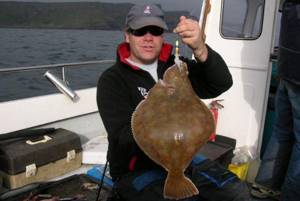
But the demand for this fish is huge, and the ban is not being observed now. Kalkan are caught in nets. They are even installed at the site of migration routes when fish go to spawn. Which greatly undermines the numbers of this valuable fish. In addition, other species, sometimes very rare, also fall into the nets of poachers.
Curious facts
Kalkan does not spawn annually. Ichthyologists can determine its age by the size of its ear pebbles. And the number of eggs can tell about the area, time and efficiency of spawning. The young Kalkan, hiding at the bottom, burrows into the ground with the help of its tail and fin. It makes wave-like movements with them, and it is covered with bottom soil. In the recess made, it becomes completely invisible.
Black Sea flounder has different wintering, feeding and spawning areas. It spawns along the shores and hides in the depths in summer. And in the fall it returns to the coast again. The older the individual, the greater the depth the fish descends. In one of the expeditions, submariners saw a Kalkan at a depth of over 10 thousand meters.
Black Sea flounder fishing began in the third century BC. In those days, women made necklaces from the thorns of this fish. A lot of fish were caught in ancient times.
Kalkan has no small bones. There are only large ones, on the ridge. Fat is concentrated mainly in the fin area. If you need low-fat meat, the fins are simply trimmed. And if this fish is baked in foil or a pot, then on the contrary, the fins must be left and no additional fat or oil can be added. Freshly frozen fish has a somewhat specific smell. But it cleans up easily. You just need to cut off the fins and pull the skin off the carcass.
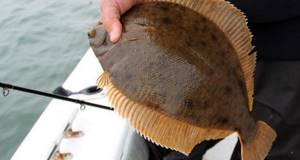
Useful properties of Kalkan
Black Sea flounder contains many useful substances and minerals for the human body. This fish is almost as valuable as the salmon family. Black Sea flounder contains Omega-3 polyunsaturated acids. Kalkan contains a whole bunch of microelements:
- sodium;
- potassium;
- cobalt;
- phosphorus;
- iodine;
- molybdenum;
- chlorine;
- sulfur;
- calcium;
- zinc;
- magnesium.
Fish also contains a number of useful amino acids that help regulate cholesterol levels:
- threonine;
- glycine;
- serine;
- aspartic;
- glutamine
This fish contains a large amount of vitamins. Vitamin A gives a person vitality and saturates with energy. It also strengthens the immune system and promotes faster healing of wounds. Vitamin B has a beneficial effect on the nervous system and improves brain function. Kalkan is a low-calorie fish, therefore ideal for diets. Vitamin C prevents inflammation and infections. And vitamin E slows down the aging of cells and improves their nutrition, strengthens blood vessels.
Thanks to these valuable components, the growth of cancer cells is prevented and the risk of obesity and diabetes is reduced.
Flounder meat and caviar - benefits and harms
The fish has a firm, delicate texture and a sweetish taste. Due to the peculiarities of the shape, when cutting, you get not a pair, but 4 fillets. The nutritional value of flounder is 90 kcal per 100 g. Due to its low calorie content and aspartic and glutamic acids, flat fish meat is a component of health and rehabilitation diets. Another advantage of flounder is the beneficial substances needed by the body:
- easily digestible proteins (15 g);
- thiamine (0.14 mg), riboflavin (0.15 mg), pyridoxine (0.12 mg);
- vitamins B12 (1.2 mcg), B9 (6 mcg), D (2.8 mcg), C (1 mcg);
- potassium (320 mg), calcium (45 mg), phosphorus (180 mg), iodine (50 mcg);
- copper (110 mcg), fluorine (430 mcg), sulfur (190 mg).
Due to its gastronomic characteristics and properties, flounder meat is considered a delicacy and a means for regulating metabolism and weight, reducing the level of “bad” cholesterol in the blood, increasing efficiency and immunity, stimulating regenerative processes in muscles, skin, and hair.
Fish lends itself well to steaming, boiling, drying, frying, smoking, cooking in batter, baking in the oven and grilling. But it is better to use gentle methods so that prolonged thermal exposure does not destroy the vitamins and richness of taste. Steamed dishes are useful for children, pregnant women, people with gastrointestinal and metabolic problems. Flounder caviar has excellent gastronomic qualities. It contains a large amount of proteins (>20%) and is a valuable source of protein, while maintaining a low calorie content of the product (80 kcal per 100 g). Popular methods of preparing caviar are salting and frying.
Contraindications
But you should not take the global benefits of flounder fish for the body as a fact. There are contraindications that need to be taken into account before eating seafood:
- individual intolerance;
- child's age up to 1 year;
- diseases of the liver and excretory system due to increased load on the kidneys and gall bladder.


